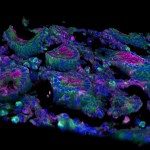Lien vers Pubmed [PMID] – 15199313
AIDS 2004 Jul; 18(10): 1371-81
The three divergent HIV-1 groups M, N and O were very probably introduced into the human population by independent cross-species transmissions of SIVcpz from the chimpanzee subspecies Pan troglodytes troglodytes in central Africa.To characterize HIV-1 group N strains and to elucidate the group’s epidemiology and relationship to HIV-1 strains O and M, and SIVcpz.DNA amplification, sequencing and phylogenetic analyses were performed to characterize viruses from three group N-infected individuals (YBF106, YBF115 and YBF116) together with YBF30 and YBF105 previously described.Full-length genome sequence was determined for virus YBF106; gag, pol and env sequences were obtained for YBF116; pol (integrase) and env (gp41) fragments were obtained for YBF115. The gag, pol, 5′-vif and nef sequences were phylogenetically more closely related to HIV-1 M while 3′-vif, vpr, tat, vpu and env clustered with SIVcpz from P. t. troglodytes. Sequence analysis revealed no mutations potentially responsible for drug resistance.The finding that all group N viruses displayed the same recombinant structure and were monophyletic indicates that a single transfer event of SIVcpz to humans can account for the origin of this group. Despite the pathogenic outcome of the known group N infections, the extremely low prevalence of this divergent HIV-1 suggests that this group is not an emerging threat to human health at the present time. However, continuous monitoring of HIV-1 diversity will be important to survey the potential of unusual HIV infections, such as group N, to contribute to the HIV/AIDS pandemic.

